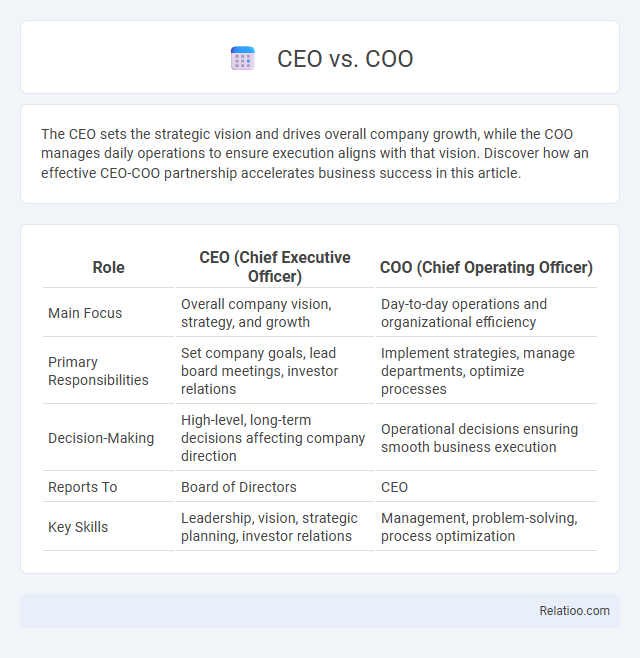The CEO sets the strategic vision and drives overall company growth, while the COO manages daily operations to ensure execution aligns with that vision. Discover how an effective CEO-COO partnership accelerates business success in this article.
Table of Comparison
| Role | CEO (Chief Executive Officer) | COO (Chief Operating Officer) |
|---|---|---|
| Main Focus | Overall company vision, strategy, and growth | Day-to-day operations and organizational efficiency |
| Primary Responsibilities | Set company goals, lead board meetings, investor relations | Implement strategies, manage departments, optimize processes |
| Decision-Making | High-level, long-term decisions affecting company direction | Operational decisions ensuring smooth business execution |
| Reports To | Board of Directors | CEO |
| Key Skills | Leadership, vision, strategic planning, investor relations | Management, problem-solving, process optimization |
CEO vs COO: Key Differences Explained
The CEO drives overall vision and long-term strategy, while the COO manages day-to-day operations to ensure business efficiency. CEOs focus on external relations, investor communications, and growth opportunities, whereas COOs prioritize internal processes, team management, and execution of the CEO's vision. Understanding these key differences empowers your leadership to balance strategic direction with operational excellence.
Understanding the Roles: CEO and COO
The CEO (Chief Executive Officer) drives overall company vision, strategic planning, and external stakeholder relations, while the COO (Chief Operating Officer) manages day-to-day operations and internal processes to ensure effective execution of strategies. Decision-makers at the executive level rely on the CEO for long-term direction and on the COO for operational efficiency and tactical implementation. Understanding these roles clarifies the division of leadership responsibilities crucial for organizational success.
Core Responsibilities of a CEO
The CEO primarily focuses on setting the company's strategic vision, making high-level decisions, and ensuring overall organizational growth and profitability. In contrast, the COO is responsible for managing daily operations, implementing the CEO's strategies, and optimizing internal processes. While decision-makers can exist at various levels, the CEO holds the ultimate authority for key corporate decisions and stakeholder relations.
Core Responsibilities of a COO
The COO oversees daily operations, ensuring efficient workflow and implementing business strategies set by the CEO to meet organizational goals. Unlike the CEO who focuses on vision and high-level decisions, the COO manages internal processes, team coordination, and operational performance metrics. Your COO translates strategic plans into executable actions, optimizing productivity and aligning resources to drive company success.
Skills and Qualities: CEO vs COO
The CEO excels in visionary leadership, strategic thinking, and high-level decision-making, guiding overall corporate direction and inspiring stakeholders. The COO demonstrates exceptional operational expertise, process optimization skills, and team management, ensuring efficient execution of daily activities. Your business benefits when the CEO's strategic foresight complements the COO's operational focus, fostering balanced decision-making and organizational success.
Reporting Structure and Authority
The CEO holds the highest authority in the reporting structure, responsible for overall strategic vision and ultimate decision-making, directly overseeing the COO. The COO manages daily operations and reports to the CEO, acting as an intermediary between executive strategy and departmental execution. Your organization's decision-maker depends on the hierarchy, with the CEO having final authority, while the COO implements and executes operational decisions within their scope.
Collaboration Between CEO and COO
The CEO and COO collaborate by aligning strategic vision with operational execution, ensuring company goals are both ambitious and achievable. The CEO focuses on high-level decision-making and external relations, while the COO manages day-to-day operations to implement strategies effectively. Their partnership enhances organizational efficiency, driving growth and adapting quickly to market changes.
Common Misconceptions About CEO and COO
The CEO primarily focuses on overarching strategic vision and external relations, while the COO handles day-to-day operational management and internal processes. A common misconception is that COOs are subordinate to CEOs, but both roles hold distinct, complementary responsibilities critical to organizational success. Decision-makers often underestimate the COO's influence on execution efficiency, mistaking the CEO as the sole authority in operational decisions.
Choosing the Right Path: CEO or COO
Choosing the right path between CEO and COO hinges on leadership style and organizational impact, with the CEO focusing on vision, strategy, and external relations while the COO drives operational efficiency and internal management. CEOs are decision-makers responsible for setting long-term goals and steering company culture, whereas COOs implement these strategies through day-to-day operations and process optimization. Understanding these distinct roles enables professionals to align their skills with the demands of executive leadership and operational excellence.
CEO vs COO: Impact on Company Success
The CEO drives overall company vision and strategic direction, while the COO focuses on operational efficiency and execution of day-to-day activities. Effective collaboration between the CEO and COO enhances organizational performance by aligning high-level goals with efficient operational processes. The CEO's visionary leadership combined with the COO's operational expertise critically impacts company success, balancing innovation and execution.

Infographic: CEO vs COO
 relatioo.com
relatioo.com